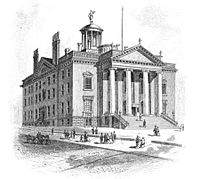42nd New York State Legislature
| 42nd New York State Legislature | |||||
|---|---|---|---|---|---|
|
|||||

The Old State Capitol (1879)
|
|||||
| Overview | |||||
| Jurisdiction | New York, United States | ||||
| Term | July 1, 1818 – June 30, 1819 | ||||
| Senate | |||||
| Members | 32 | ||||
| President | Lt. Gov. John Tayler (Dem.-Rep.) | ||||
| Party control | Bucktail plurality | ||||
| Assembly | |||||
| Members | 126 | ||||
| Speaker | Obadiah German (Clint.) | ||||
| Party control | Clintonian plurality | ||||
| Sessions | |||||
|
|||||
| 1st | January 5 – April 13, 1819 |
|---|
The 42nd New York State Legislature, consisting of the New York State Senate and the New York State Assembly, met from January 5 to April 13, 1819, during the second year of DeWitt Clinton's governorship, in Albany.
Under the provisions of the New York Constitution of 1777, amended by the Constitutional Convention of 1801, 32 Senators were elected on general tickets in the four senatorial districts for four-year terms. They were divided into four classes, and every year eight Senate seats came up for election. Assemblymen were elected countywide on general tickets to a one-year term, the whole Assembly being renewed annually.
In 1797, Albany was declared the State capital, and all subsequent Legislatures have been meeting there ever since. In 1818, the Legislature enacted that future Legislatures meet on the first Tuesday of January of each year unless called earlier by the governor.
In 1816, Hamilton County was split from Montgomery County, but both remained together in one Assembly district. Also in 1816, Oswego County was formed from parts of Oneida and Onondaga counties, and Oswego and Oneida remained together in one Assembly district.
In 1818, Joseph Ellicott resigned from the Erie Canal Commission, due to ill health. On June 18, during the recess of the Legislature, Gov. DeWitt Clinton appointed State Senator Ephraim Hart to fill the vacancy temporarily.
At this time the politicians were divided into two opposing political parties: the Federalists and the Democratic-Republicans. The Democratic-Republican Party was split into two factions: the Clintonians (supporters of Gov. DeWitt Clinton and his Erie Canal project) and the Bucktails (led by Att. Gen. Martin Van Buren, and including the Tammany Hall organization in New York City).
...
Wikipedia
